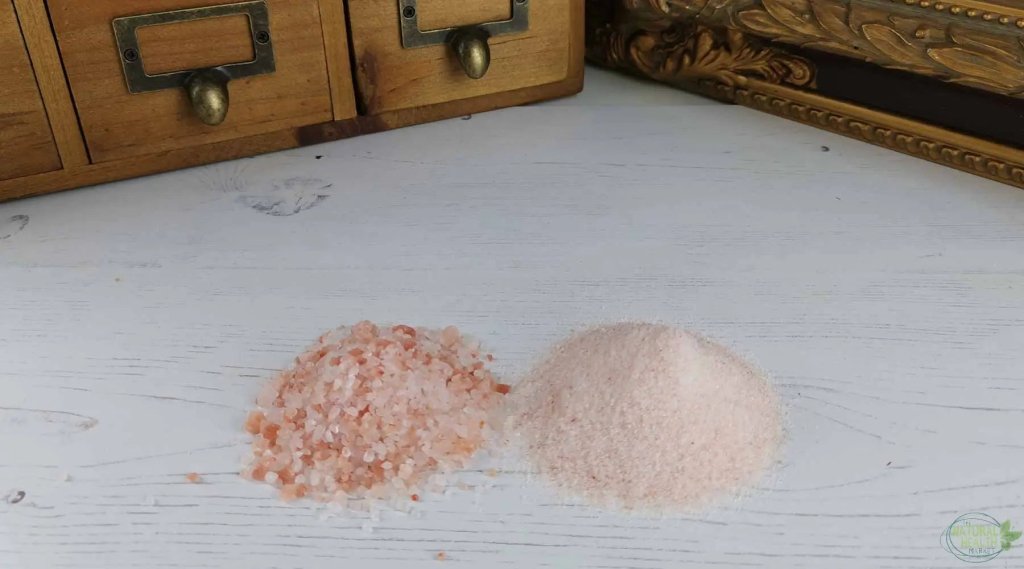
Himalayan Pink Rock Salt Contains Over 80 Minerals
Himalayan Pink Rock Salt is harvested from the foothills of the Himalayan mountain range in Northern Pakistan, formed over millions of years the salt has been infused with over 80 minerals and trace elements as it has formed.
We sell Pink Himalayan Rock Salt in two forms, corse and fine which can be purchased HERE...
With the continued and widely publicised polluting of our planet's oceans high altitude rock salt is quickly gaining notoriety as being a clean and pure source of salt, tagged on to this as it is formed over millennia it absorbs a plethora of minerals and elements.
Listed below is a list of minerals and elements Himalayan Rock Salt contains.
| 84 MINERALS HIMALAYAN PINK SALT | CONCENTRATION per 100g |
| Hydrogen | 0.30 g/kg |
| Lithium | 0.40 g/kg |
| Beryllium | <0.01 ppm |
| Boron | <0.001 ppm |
| Carbon | <0.001 ppm |
| Nitrogen | 0.024 ppm |
| Oxygen | 1.20 g/kg |
| Flouride | <0.1 g/kg |
| Sodium | 382.61 g/kg |
| Magnesium | 0.16 g/kg |
| Aluminium | 0.661 ppm |
| Silicon | <0.1 g/kg |
| Phosphorus | <0.10 ppm |
| Sulfur | 12.4 g/kg |
| Chloride | 590.93 g/kg |
| Potassium | 3.5 g/kg |
| Calcium | 4.05 g/kg |
| Scandium | <0.0001 ppm |
| Titanium | <0.001 ppm |
| Vanadium | 0.06 ppm |
| Chromium | 0.05 ppm |
| Manganese | 0.27 ppm |
| Iron | 38.9 ppm |
| Cobalt | 0.60 ppm |
| Nickel | 0.13 ppm |
| Copper | 0.56 ppm |
| Zinc | 2.38 ppm |
| Gallium | <0.001 ppm |
| Germanium | <0.001 ppm |
| Arsenic | <0.01 ppm |
| Selenium | 0.05 ppm |
| Bromine | 2.1 ppm |
| Rubidium | 0.04 ppm |
| Ytterbium | <0.001 ppm |
| Zirconium | <0.001 ppm |
| Niobium | <0.001 ppm |
| Molybdenum | 0.01 ppm |
| Technetium | unstable artificial isotope |
| Ruthenium | <0.001 ppm |
| Rhodium | <0.001 ppm |
| Palladium | <0.001 ppm |
| Silver | 0.031 ppm |
| Cadmium | <0.01 ppm |
| Indium | <0.001 ppm |
| Tin | <0.01 ppm |
| Antimony | <0.01 ppm |
| Tellurium | <0.001 ppm |
| Iodine | <0.1 g/kg |
| Cesium | <0.001 ppm |
| Barium | 1.96 ppm |
| Lanthan | <0.001 ppm |
| Cerium | <0.001 ppm |
| Praseodymium | <0.001 ppm |
| Neodymium | <0.001 ppm |
| Promethium | unstable artificial isotope |
| Samarium | <0.001 ppm |
| Europium | <3.0 ppm |
| Gadolinium | <0.001 ppm |
| Terbium | <0.001 ppm |
| Dysprosium | <4.0 ppm |
| Holmium | <0.001 ppm |
| Erbium | <0.001 ppm |
| Thulium | <0.001 ppm |
| Ytterbium | <0.001 ppm |
| Lutetium | <0.001 ppm |
| Hafnium | <0.001 ppm |
| Tantalum | 1.1 ppm |
| Wolfram | <0.001 ppm |
| Rhenium | <2.5 ppm |
| Osmium | <0.001 ppm |
| Iridium | <2.0 ppm |
| Platinum | 0.47 ppm |
| Gold | <1.0 ppm |
| Mercury | <0.03 ppm |
| Thallium | 0.06 ppm |
| Lead | 0.10 ppm |
| Bismuth | <0.10 ppm |
| Polonium | <0.001 ppm |
| Astat | <0.001 ppm |
| Francium | <1.0 ppm |
| Radium | <0.001 ppm |
| Actinium | <0.001 ppm |
| Thorium | <0.001 ppm |
| Protactinium | <0.001 ppm |
| Uranium | <0.001 ppm |
| Neptunium | <0.001 ppm |
| Plutonium | <0.001 ppm |
Himalayan Pink Rock Salt: Over 80 Minerals and Their Benefits
Himalayan pink rock salt has gained worldwide popularity, not just for its striking colour but for its rich mineral content and potential health benefits. With over 84 trace minerals, this natural salt is more than just a seasoning—it's a wellness staple. In this article, we’ll explore the minerals in Himalayan pink salt, their benefits, and how you can use it in your daily routine.
What Is Himalayan Pink Rock Salt?
Himalayan rock salts are mined from ancient salt deposits in the Punjab region of Pakistan, near the Himalayan mountains. Unlike regular table salt, Himalayan mineral salt is unprocessed and free from additives, retaining its natural trace minerals.
What Are the 84 Minerals in Himalayan Pink Salt?
One of the key reasons Himalayan rock salt is highly valued is its mineral composition. While the majority of it is sodium chloride (98%), the remaining 2% consists of essential minerals and trace elements.
| Mineral | Benefit |
|---|---|
| Potassium | Supports muscle function and heart health |
| Magnesium | Helps with relaxation, energy production, and bone health |
| Calcium | Essential for strong bones and teeth |
| Iron | Vital for oxygen transport and energy levels |
| Zinc | Boosts immune function and skin repair |
These Himalayan pink salt trace minerals are present in small amounts, but they contribute to its unique colour and subtle flavour differences.
Health Benefits of Himalayan Mineral Salt
Although Himalayan rock salt contains essential minerals, it’s important to understand that these are in **trace amounts** and do not significantly impact daily nutritional intake. However, many people prefer it over processed table salt for the following reasons:
- Unrefined & Pure: Free from additives and anti-caking agents.
- Electrolyte Balance: May help maintain hydration and support muscle function.
- Rich in Minerals: Contains Himalayan pink salt trace minerals that add a unique flavour to dishes.
- Alkaline Properties: Some believe it helps balance pH levels in the body.
How to Use Himalayan Rock Salt
There are many ways to incorporate Himalayan rock salts into your lifestyle beyond seasoning your meals:
1. Cooking & Seasoning
Use Himalayan mineral salt to enhance the flavour of your dishes. It works well in everything from soups and stews to grilled meats and vegetables.
2. Himalayan Rock Salt Bath
A Himalayan rock salt bath is a luxurious way to relax and detoxify. Adding salt to warm water may help soothe sore muscles and nourish the skin with essential minerals.
3. Salt Lamps & Air Purification
Himalayan salt lamps are said to improve air quality by releasing negative ions, though scientific evidence on their efficacy is limited.
4. Homemade Skincare
Mix Himalayan mineral salt with coconut oil for a natural exfoliating scrub that removes dead skin cells and leaves your skin feeling smooth.
Himalayan Rock Salt vs Table Salt: Which Is Better?
Regular table salt is heavily processed and often contains anti-caking agents and added iodine. In contrast, Himalayan pink rock salt is unrefined and naturally rich in trace minerals. However, both salts should be consumed in moderation.
FAQs
Is Himalayan rock salt healthier than table salt?
Himalayan salt is less processed and contains small amounts of natural trace minerals, but both salts have similar sodium content.
Can you drink Himalayan rock salt water?
Some people make a “sole” solution by dissolving pink rock salt in water, believing it helps with hydration and electrolyte balance.
Should You Use Himalayan Salts?
Whether you’re using it for cooking, bathing, or skincare, Himalayan pink rock salt is a natural alternative to refined salt. While the 84 minerals in Himalayan pink salt are present in trace amounts, they contribute to its distinctive properties and appeal.
Try incorporating this mineral-rich salt into your routine and experience its natural benefits today!
